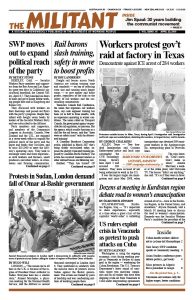Freight rail bosses across North America are cutting training time and standards — on top of reducing crew size and running much longer trains — to save money and boost profits, regardless of the risks to the safety of rail workers and the surrounding communities.
Teamsters Canada Rail Conference, the union that organizes rail workers there, says new engineer training has been cut in half to three months, with no experience operating in winter conditions. The union called on Transport Canada, the government agency responsible for rail regulation, to intervene. But the agency, which usually functions as a shill for the rail bosses, said that “there were no safety issues” with the abbreviated training!
A Canadian Broadcast Corporation article, published in March 2017 that’s being widely recirculated today, exposes the sharply truncated training imposed by Canadian Pacific Railway. The article has received renewed interest as other railroad bosses are following suit.
Entitled, “‘They Are Scared’: CP Workers Say Rookie Engineers Ill-Prepared for Dangerous Job,” the article describes a near disaster involving a more than 27,000-ton one-and-a-half-mile-long Canadian Pacific train barreling downhill in British Columbia.
The new engineer hadn’t ensured sufficient air pressure for the brakes on the steep descent. The conductor, who had years of experience, overrode the controls, applying the emergency brakes just in time.
In 2013 Canadian Pacific began requiring its office workers and managers to train and qualify as conductors and engineers. The company says it needs them in case of emergencies, labor shortages — and strikes.
Unlike union engineers, who first have to work for two years as conductors, office workers and managers go straight to classroom instruction and two to four weeks practicing on simulators before they do some supervised runs on real trains. Canadian Pacific rail bosses cynically call this “state of the art” training.
“Simulators are not adequate compared to years of hands-on training and running experience,” Jack Krueger, 63, a member of the Brotherhood of Locomotive Engineers and Trainmen, told the Militant. Krueger has worked in freight and passenger service as a locomotive engineer for almost 40 years in and out of Lincoln, Nebraska. In the last two years “almost all railroads in North America have gone over to training engineers largely by simulators,” he said.
Train engineers have to be aware of the train’s weight and speed, the track incline, weather and other factors. Depending on conditions, it can take a mile to stop after applying the brakes. Operators need to know their territory, Krueger said. Otherwise you can head into a curve too fast, run through a red signal you didn’t expect, and other errors that can cause the train to derail, or worse.
“It takes two to three years experience to work safely with confidence” in large rail yards like the Lincoln terminal, “where there are half-a-dozen rail lines with over-the-road trains leaving or coming,” Lance Anton, a conductor and member of the SMART rail union in Lincoln, told the Militant.
Bosses’ moves upend safety
“A Revolution Sweeping Railroads Upends How America Moves Its Stuff,” was the headline of an April 3 Wall Street Journal article that reported on how rail bosses are using what’s called “precision-scheduled railroading.” Canadian Pacific, Canadian National, CSX, Union Pacific and other major rail companies have turned to this scheme. Their aim is to move more freight with fewer trains and workers, by holding businesses that need pickups or deliveries to a tighter schedule and reducing the time equipment is idle in rail yards.
This is based on a speedup of yard workers who must switch cars and locomotives more rapidly between incoming and outgoing trains. And more and more of these jobs are being done by a one-person crew using a remote control to operate the trains. Railroad stocks went up tens of billions of dollars in the past six months “as investors anticipate lower costs and higher profits,” the Journal said.
Norfolk Southern bosses say they hope to use the new system to cut 3,000 employees from its workforce of 26,000 and shed 500 locomotives of its 4,100.
Even before “precision scheduling,” rail bosses’ have been eliminating rail jobs and making significant — and dangerously fatiguing — changes to work schedules. More engineers and conductors are now drawn from “pools,” and are expected to run trains on a larger number of routes on a moment’s notice.
Only through solidarity can rail workers and others find the ways to fight the bosses’ moves, and organize to use union power to impose workers control of training, crew size, schedules and working conditions.
Joe Swanson from Lincoln, Nebraska, contributed to this article.

